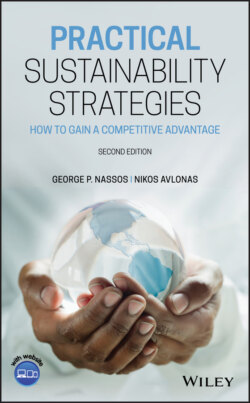Читать книгу Practical Sustainability Strategies - George P. Nassos - Страница 24
CHAPTER 2 Development of the Sustainability Concept and CSR
ОглавлениеIn 1983, the United Nations convened the World Commission on Environment and Development and was chaired by Dr. Gro Harlem Brundtland who was the Prime Minister of Norway at the time. The agenda of this commission was the concern with the accelerating deterioration of the human environment and natural resources and the consequences of that deterioration for economic and social development. The final report was published in 1987 as “Our Common Future” [1] and resulted in the definition of sustainable development, or sustainability for short:
Sustainable development is development that meets the needs of the present without compromising the ability of future generations to meet their own needs.
This has become now well-known as the Brundtland definition of sustainability, but there are many other definitions that really all mean the same—protecting the environment so it will be available for the people forever. A definition developed for the Center for Sustainable Enterprise at the Illinois Institute of Technology—Stuart School of Business [2] is:
The practice of sustainable development assures that the natural resources and energy we use to provide today's products and services will not deny future generations the resources necessary to meet their needs while building and preserving communities that are economically, socially and environmentally healthy.
The impact on the environment can also be presented as a mathematical relationship. For instance,
where EB is environmental burden; P is population; A is affluence; and T1 is technology.
Environmental burden refers to the negative impact on the environment, which is a function of (i) the population, (ii) affluence or consumption by this population, and (iii) technology that enhances or mitigates this impact. This formula can be restated as follows:
where T2 is the inverse of technology.
But now, the technology is what creates products and services sustainable. Population and affluence are really inversely proportional, as the population increases, consumption tends to decrease. As the people become more educated and consumption increases, the population tends to decrease. However, if the population was to double and the consumption was to, say, increase by 10-fold, technology would have to increase by 20-fold to keep the environmental burden constant.
The bottom line to this discussion is that there is an urgent need for corporations, government agencies, non-governmental organizations (NGOs), and individuals to find ways to be sustainable and to implement them. Chapters 3–17 in Part 2 will provide strategies for everyone, but for corporations in particular to develop, maintain, or extend a competitive advantage without having a negative impact on the environment. Being more efficient in energy usage, water usage, natural resource usage, and creating less waste are all very, very important. These can all be classified as being less bad. However, being “LESS BAD IS NOT ENOUGH.”
While most corporations are very concerned with profitability, implementing sustainability does not necessarily mean an opposition to profitability. In fact, these two terms are complementary. By striving for corporate sustainability, the company will achieve long-term profitability. This is the goal for all corporate stakeholders, a term first used by multinational companies in the late 1960s and early 1970s, referring to all people and entities upon which the company has an impact. At the same time, the term Corporate Social Responsibility (CSR) was used to describe the process with an aim to embrace responsibility for the company's actions and encourage a positive impact through its activities on the environment, consumers, employees, communities, stakeholders, and anyone else in the public sphere who may also be considered as stakeholders. While this term was not widely used during the next three decades, it is currently used often to describe a company's integration of sustainability in its operations. Perhaps a more accurate name for the process would be Corporate Social Responsibility and Sustainability, or CSR and Sustainability as used by McDonald's Corporation [3].
In 2011, the European Commission defined CSR as “a concept whereby companies integrate social and environmental concerns in their business operations and in their interaction with their stakeholders on a voluntary basis” [4].
CSR concerns actions by companies over and above their legal obligations toward society and the environment. Certain regulatory measures create an environment more conducive to enterprises voluntarily meeting their social responsibility.
According to European Union (EU) policy, a strategic approach to CSR is increasingly important to the competitiveness of enterprises. It can bring benefits in terms of risk management, cost savings, access to capital, customer relationships, human resource management, and innovation capacity.
Because CSR requires engagement with internal and external stakeholders, it enables enterprises to anticipate better and take advantage of fast changing societal expectations and operating conditions. It can therefore drive the development of new markets and create opportunities for growth.
By addressing their social responsibility, enterprises can build long-term employee, consumer, and citizen trust as a basis for sustainable business models. Higher levels of trust in turn help to create an environment in which enterprises can innovate and grow. Through CSR, enterprises can significantly contribute to the European Union's treaty objectives of sustainable development and a highly competitive social market economy. CSR underpins the objectives of the Europe 2020 strategy for smart, sustainable, and inclusive growth, including the 75% employment target. Responsible business conduct is especially important when private sector operators provide public services. Helping to mitigate the social effects of an economic crisis, including job losses, is part of the social responsibility of enterprises. CSR offers a set of values on which to build a more cohesive society and on which to base the transition to a sustainable economic system.
